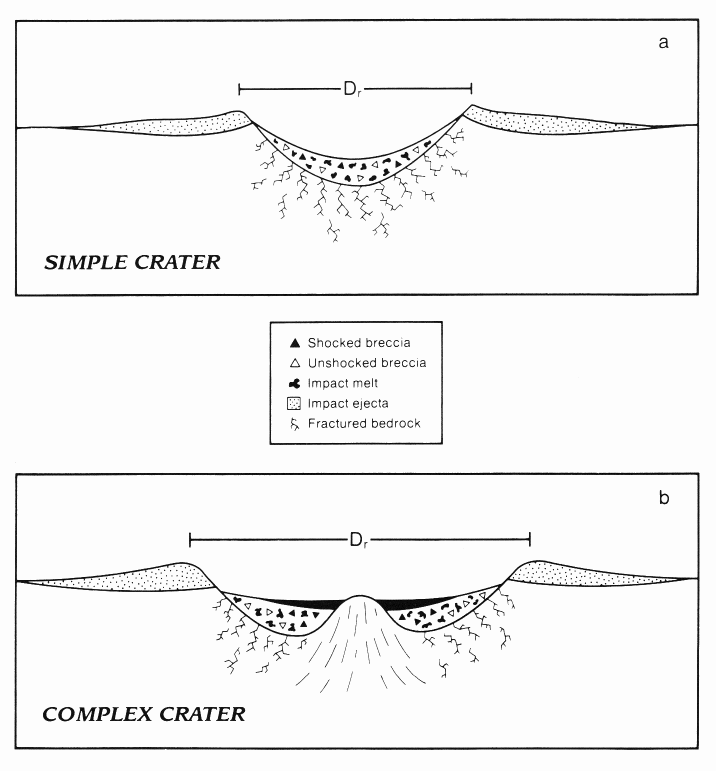|
For a printer friendly version of this lab, click here. Background: Impact craters are geologic structures formed when a large meteoroid, asteroid or comet crashes into a planet. All of the planets in our solar system have been heavily bombarded throughout the formation of our system. Several planets, notably Mercury and Mars, along with the moons of the other planets and including our own Moon, show the record of this bombardment. This record has been preserved due to the lack of geologic activity such as erosion and deposition. Here on Earth, while many impact craters have been erased by volcanic eruptions; earthquakes; erosion; and many other geological processes, we can still find evidence of impact craters in areas where there is little geologic disturbance. Thanks to satellites and telescopes, we have been able to identify many structures that were once thought of as extinct volcanoes, as actually the result of impact craters. Impact craters are divided into two groups: simple craters and complex craters. Simple craters are relatively small with depth-to-diameter ratios of about 1:5 to 1:7 and a smooth bowl shape. In larger craters, however, gravity causes the initially steep crater walls to collapse downward and inward, forming a complex structure with a central peak or peak ring and a shallower depth compared to diameter (1:10 to 1:20). The diameter at which craters become complex depends on the surface gravity of the planet: The greater the gravity, the smaller the diameter that will produce a complex structure. The central peak or peak ring of the complex crater is formed as the initial (transient) deep crater floor rebounds from the compression shock of impact. Slumping of the rim further modifies and enlarges the final crater.
Large terrestrial impacts are of great importance in the study of our planet. For example, recent studies of the Cretaceous/Tertiary boundary, which marks the abrupt demise of a large number of biological species including dinosaurs, revealed unusual enrichments of siderophile elements and shock metamorphic features that are markers of meteorite impact events. Most researchers now believe that a large asteroid or comet hit the Earth at the end of the Cretaceous Period - about 66 million years ago. A climatically induced environmental crisis triggered by the gigantic collision contributed to the mass extinctions. Based on apparent correspondences between periodic variations in the marine extinction record and the impact record, some scientists suggest that large meteorite impacts might be the "match that lights the fire" setting off various biological evolution "revolutions" on Earth - an unproven but intriguing hypotheses.
Laboratory Activity Objective: This lab will allow you to find out how the impacts of meteorites have shaped planet's and moon's surfaces.
Materials: flour; flat pan; metric ruler; cinnamon; small pebbles; hand lens; tweezers
Procedure: 1. Sift flour into a pan forming a layer of flour 2 cm deep. Sprinkle a thin layer of cinnamon on top of the flour. This forms a model of the surface of a planet. 2. Drop a pebble into the flour from a height of 1 m. The pebble represents a meteorite making a crater on the surface of a planet. 3. Using the hand lens, observe the crater. Measure its diameter. Describe the rim of the crater and any matter thrown from the crater. Record all observations. 4. Using the tweezers, carefully remove the meteorite from the crater - be sure not to disturb the surrounding crater walls. 5. Repeat the process using each pebble specimen and dropping them from various heights. Record all observations on your chart.
Data Table:
Questions: 1. What are the shapes of your craters? 2. Does the shape of the crater depend on the shape of the meteorite that produced it? Why or why not? 3. Did you observe long lines, or rays of matter, running outward from your craters? What do you suppose causes this "ejecta" on some impacts, but not on others? 4. How did the height from which you dropped your meteorite affect the crater it made? How does the size of the meteor affect the size of the crater? 5. When two (2) craters overlap, how can you tell which one formed first? Remember that when writing up your lab report, you must follow the proper format.
< Lab Notes > |
|||||||||||||||
